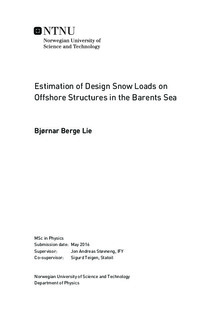Estimation of Design Snow Loads on Offshore Structures in the Barents Sea
Master thesis
Permanent lenke
http://hdl.handle.net/11250/2392295Utgivelsesdato
2016Metadata
Vis full innførselSamlinger
- Institutt for fysikk [2686]
Sammendrag
Snow accumulating on offshore structures can reduce freeboard and stability, block equipment and valves, and reduce operability of the platform or ship. It is thus important to evaluate snow conditions before starting long term operations. However, offshore snow condtitions in the Barents Sea are largely unquantified.
The present study investigates snow loads on offshore structures in the Barents Sea.We have implemented a model to establish time series of snow loads using a 10-day snowfall model or an energy balance model, with or without snow transport by wind. Methods to estimate extreme value statistics have also been applied, specifically using the generalized extreme value distribution and the peak-over-threshold method. These models have been applied with meteorological data from NORA10 hindcast grid points covering the entire Barents Sea to provide estimates of extreme snow loads. The results for a 10-day snowfall model without drift show 100-year return levels of snow load to be 70~kg/m$^2$ (0.68~kPa) to 120~kg/m$^2$ (1.18~kPa) in the area opened to petroleum activity in the Norwegian sector of the Barents Sea. Indication of a declining trend in the extreme values has also been found in the southern Barents Sea. The hindcast archive NORA10 was validated against observations to evaluate uncertainties in the hindcast. NORA10 shows a wet bias at all locations, but the distribution of extreme precipitation is similar to the observations. Due to undercatch of snow in the observations, it is likely that NORA10 underestimates extreme precipitation.
